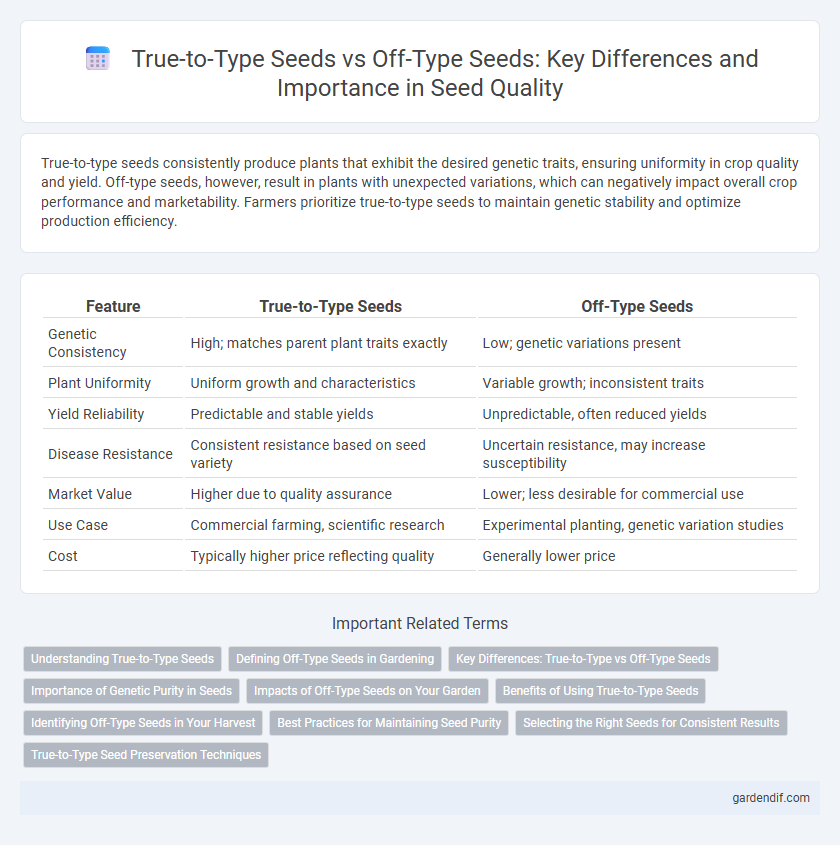
True-to-Type Seeds vs Off-Type Seeds Illustration
True-to-type seeds consistently produce plants that exhibit the desired genetic traits, ensuring uniformity in crop quality and yield. Off-type seeds, however, result in plants with unexpected variations, which can negatively impact overall crop performance and marketability. Farmers prioritize true-to-type seeds to maintain genetic stability and optimize production efficiency.
Table of Comparison
| Feature | True-to-Type Seeds | Off-Type Seeds |
|---|---|---|
| Genetic Consistency | High; matches parent plant traits exactly | Low; genetic variations present |
| Plant Uniformity | Uniform growth and characteristics | Variable growth; inconsistent traits |
| Yield Reliability | Predictable and stable yields | Unpredictable, often reduced yields |
| Disease Resistance | Consistent resistance based on seed variety | Uncertain resistance, may increase susceptibility |
| Market Value | Higher due to quality assurance | Lower; less desirable for commercial use |
| Use Case | Commercial farming, scientific research | Experimental planting, genetic variation studies |
| Cost | Typically higher price reflecting quality | Generally lower price |
Understanding True-to-Type Seeds
True-to-type seeds consistently produce plants with genetics identical to the parent plant, ensuring uniformity and reliability in crop characteristics such as size, color, and yield. These seeds are crucial for farmers and gardeners aiming for predictability and quality in their harvests, as they minimize genetic variation and unexpected traits. Certified seed producers rigorously test and label true-to-type seeds to guarantee purity and performance, supporting sustainable agriculture and market standards.
Defining Off-Type Seeds in Gardening
Off-type seeds in gardening refer to seeds that produce plants exhibiting traits different from the expected or standard characteristics of the true-to-type variety. These seeds often result from genetic mutations, cross-pollination, or environmental factors, leading to variations in flower color, fruit shape, or plant vigor. Identifying off-type seeds is crucial for maintaining crop uniformity and ensuring the reliability of seed stocks for growers.
Key Differences: True-to-Type vs Off-Type Seeds
True-to-type seeds guarantee offspring with traits identical to the parent plant, ensuring consistency in yield, flavor, and growth characteristics. Off-type seeds produce plants with variations in phenotype, often leading to unpredictable qualities and reduced crop uniformity. Farmers and breeders prioritize true-to-type seeds for reliable production and market standards, while off-type seeds may be used for breeding or experimental purposes.
Importance of Genetic Purity in Seeds
Genetic purity in seeds ensures that true-to-type seeds reliably produce plants with uniform traits, crucial for maintaining crop quality and yield consistency. Off-type seeds can introduce genetic variability, leading to reduced performance and unpredictability in traits such as size, color, and disease resistance. Maintaining strict genetic purity standards safeguards farmers' investments and supports sustainable agriculture by delivering predictable, high-quality harvests.
Impacts of Off-Type Seeds on Your Garden
Off-type seeds often result in plants with unpredictable traits that can reduce uniformity and yield in your garden. These seeds may produce flowers, fruits, or vegetables that vary in size, shape, or color, impacting the overall aesthetic and harvest quality. Maintaining true-to-type seeds ensures genetic consistency, improving plant performance and garden productivity.
Benefits of Using True-to-Type Seeds
True-to-type seeds ensure genetic uniformity and consistent crop quality, leading to predictable plant traits and higher yields. Utilizing true-to-type seeds reduces the risk of undesirable traits and enhances resistance to pests and diseases. This consistency supports efficient farm management and improves marketability of agricultural produce.
Identifying Off-Type Seeds in Your Harvest
Identifying off-type seeds in your harvest requires careful observation of seed morphology, including variations in size, shape, and color compared to true-to-type seeds. Off-type seeds often display irregular germination patterns and may result in inferior plant vigor or unexpected traits, impacting crop uniformity and yield quality. Utilizing seed testing and genetic verification techniques enhances accurate identification, ensuring only true-to-type seeds are selected for future planting.
Best Practices for Maintaining Seed Purity
Maintaining seed purity requires rigorous selection of true-to-type seeds, which genetically match the parent plant, while systematically identifying and removing off-type seeds that exhibit undesirable traits. Implementing controlled pollination, regular field inspections, and genetic testing ensures high seed quality and uniform crop performance. Proper storage and handling protocols further preserve seed viability and prevent contamination, safeguarding the genetic integrity of the seed lot.
Selecting the Right Seeds for Consistent Results
True-to-type seeds ensure genetic consistency and uniformity, producing plants that match the expected traits essential for reliable crop yields. Off-type seeds can introduce variability, leading to unpredictable plant characteristics and compromised quality, impacting overall production efficiency. Selecting true-to-type seeds from reputable sources guarantees consistent results and optimal performance in agricultural operations.
True-to-Type Seed Preservation Techniques
True-to-type seed preservation relies on meticulous selection, isolation, and controlled pollination to maintain genetic purity and desired phenotypic traits. Techniques such as roguing, which removes off-type plants during growth, combined with careful seed harvesting and storage under optimal environmental conditions, ensure seed viability and trait consistency. Employing molecular markers further refines seed selection, enhancing the accuracy of true-to-type seed identification and preservation.
True-to-Type Seeds vs Off-Type Seeds Infographic

 gardendif.com
gardendif.com